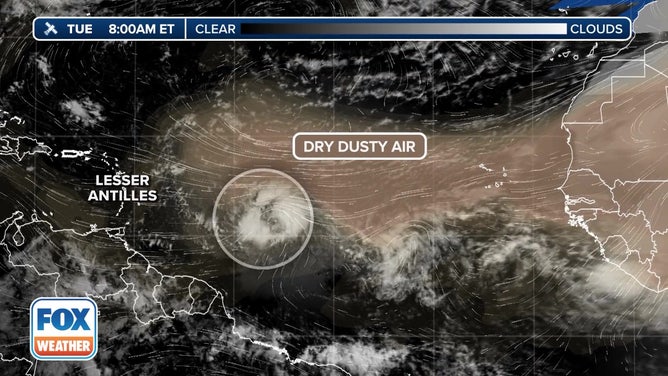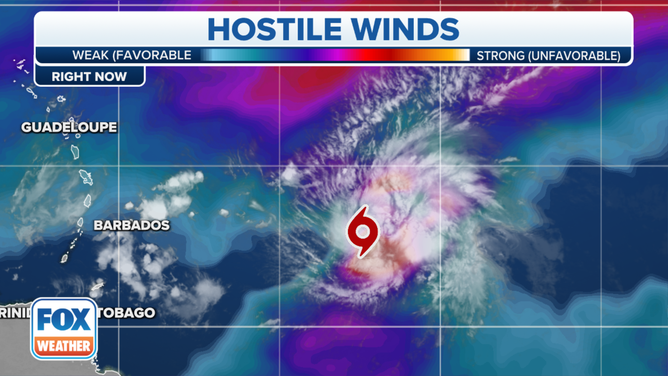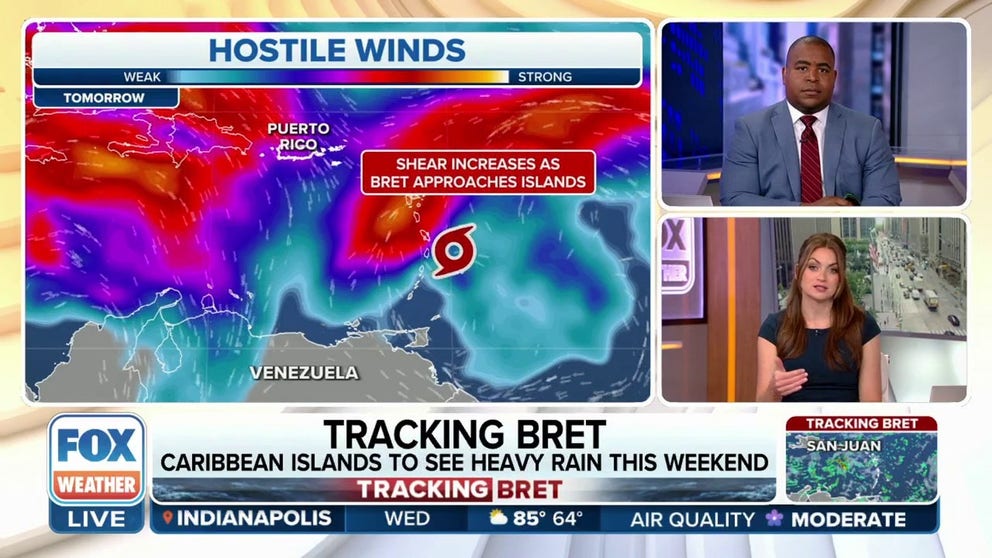Why Tropical Storm Bret's days are numbered as it approaches the Caribbean Sea
Tropical Storm Bret did manage to gain some strength Wednesday morning, fueled by the ultra-warm waters of the tropical Atlantic. Still, some dry, dusty air blowing in from the Sahara Desert was already disturbing Bret's development.
What will lead to Tropical Storm Bret's demise?
Tropical Storm Bret is making its way toward the Lesser Antilles but once past there, Bret will find some challenges maintaining its strength, as FOX Weather's Britta Merwin and Jason Frazer explain.
Tropical Storm Bret continued its trek west across the Atlantic Wednesday, setting its sights on some of the Caribbean islands of the Lesser Antilles for arrival on Thursday.
But once the tropical storm passes through those islands, it will enter the Caribbean Sea. Where could Bret go next?
All indications are Bret will instead soon meet its demise, as the current atmospheric setup will become more hostile to tropical storms.
Dust in the wind
Bret did manage to gain some strength Wednesday morning, fueled by the ultra-warm waters of the tropical Atlantic, but some dry, dusty air blowing in from the Sahara Desert was already disturbing Bret's development.

(FOX Weather)
7 FACTS TO KNOW ABOUT HURRICANES
"We also have some dry air getting wrapped up in Bret," FOX Weather meteorologist Jane Minar said. "That dry air is keeping convection down, especially on the southern side of the storm. As it gets wrapped up in the center of circulation, it’s not going to help that intensification inside the core of the system."
The storm is expected to maintain tropical storm strength as it passes through the Lesser Antilles Thursday. But once on the other side, it will succumb further to another atmospheric foe: wind shear.
Wind shear: Nature's ultimate tropical storm killer
Wind shear is when you have wind speeds and directions changing with altitude. In Bret's case, the upper-level winds will push against Bret's forward motion, like trying to walk into a large blow-dryer.

(FOX Weather)
The upper-level winds will pull apart the tropical storm's convection, weakening and eventually killing off the storm's development.
"These strong winds are coming in from the west," FOX Weather meteorologist Britta Merwin said. "That will push a lot of the active weather, the thunderstorms, the strong winds and the heavy rain to the east of this system. So although Bret might be moving through (the islands) Thursday, some of that worst weather might be a little delayed due to that strong wind shear. And eventually, it’s going to win out, and Bret will fall apart in the open Caribbean."
What's left of Bret is expected to continue to track to the west, perhaps eventually bringing a few remnant showers or thunderstorms to Central America.
"This is not going to be an issue to the U.S. mainland," Merwin said. "But for Puerto Rico, we’ll look out for those thunderstorms that might be lofted in that direction as we move our way through the weekend."
